Tomcat
Professional
- Messages
- 2,688
- Reaction score
- 1,015
- Points
- 113

For many centuries, since the invention of money, there has been a confrontation between currency issuers and counterfeiters. The former use increasingly sophisticated methods of protection, while the latter find ways to counterfeit them. Modern banknotes have such complex security features that checking them is impossible without special technical means. In addition, it is often necessary to provide authentication without human intervention at all, for example, in payment terminals, or in banks when automated processing of large volumes of cash.
Let's take a closer look at how modern currencies are protected, how authentication occurs and what kind of equipment is used for this.
Human-readable features
A huge number of methods of protection against counterfeiting have been invented. But unfortunately, not all of them are suitable for automatic validation. Either the security element is difficult to count and represent in digital form, or there are no clear “pass/fail” criteria, or both. So the best validator is still the keen eye of an expert.Human-readable signs are very diverse and interesting, and more and more new ones are invented every year. In a good way, their description deserves a separate article, but since we will talk further about the equipment, we will limit ourselves to a short list.
- Watermark. Images created by sections of paper of different densities are visible through transmission. Perhaps the most famous sign.
- Security thread. Metal or polymer tape embedded in the thickness of the paper. Can be simple or diving. The diving thread repeatedly reaches the surface of the sheet and plunges back.
- Microprinting. The design of a banknote may contain tiny characters, usually the denomination or bank designation, or simply small elements that are only visible under magnification.
- Protective fibers. Scraps of multi-colored threads located in paper pulp. The fiber can be simple or woven from several threads of different colors.
- Microperforation. Laser-punched, even, identical small holes that make up an image or inscription. Like watermarks, they are revealed by light. The relief of the holes should not be felt with your fingers, and the paper around them should not be charred.
- Relief printing. Inscriptions and drawings that are distinguishable by touch. They perform both a utilitarian function (tags for the blind) and an anti-counterfeit function.
- Kipp effect. A corrugated section of the surface, on the side edges of the corrugations there is an image that is visible only when viewed from an acute angle.
- Matching images. A drawing in which different elements are located on different sides of the sheet. When viewed against the light, the parts must fit together exactly and give a complete image.
- Oryol seal. Thin lines, the color of which changes along the line without visible interruptions or creeping colors. Conventional multicolor printing will inevitably produce a color registration error in this case.
- Foil stamping. A design made with metal foil pressed onto the surface of the paper.
- MVC. Moiré stripes of different colors, which are visible when the banknote is tilted.
- OVI. Optically variable paint. An element that changes color depending on the angle at which you look at it.
- Hologram. An element that produces a three-dimensional holographic image that rotates when the banknote is tilted.
Machine-readable features
But what should machines consider and check? The set of machine-readable signs of authenticity is much more modest.Banknote dimensions
The overall dimensions of a banknote, strictly speaking, are not considered security features, but most detectors check them first. First of all, this allows you to immediately cut off any debris: scraps of banknotes, foreign objects, stuck together and folded money. And secondly, this is a simple but fairly reliable way to recognize the currency and denomination of the banknote.Dimensions are checked optically by scanning in transmitted light. If the device is not equipped with a full-size scanner, it can only determine one of the sizes by measuring the time the banknote covers the sensors as it is pulled through the mechanism. Also, by weakening the light flux, the device detects double banknotes.
Visible image
The image of a banknote in visible light is obtained by scanning, either in transmitted light, or in reflected light (each side separately), or both. The device can not test the entire surface, but only several characteristic zones. In this case, separate sensors are sufficient, each of which is an optocoupler: LED + photodiode.Reliable validation requires a complete image, in which case photodetecting arrays similar to those found in conventional scanners are used. The resolution of the rulers can range from 10 to 200 DPI, and increasing the resolution does not always lead to an increase in recognition quality.
Scanning can be carried out in one color (usually red, less often white), or it can be full color. In the second case, the scanner contains several color channels. These are not always standard RGB. Basic colors are selected based on the paint spectra of the currency being recognized. There can be more than three colors: say, red (640 nm), green (525 nm), blue (~450 nm) and dark red (~750 nm, almost on the border with infrared), in which the features of the US dollar pattern are clearly visible .
Infrared image
The image in infrared light (880-940 nm) is one of the main machine-readable features. When printing banknotes, special ones are used, so-called. metameric paints . A pattern made with such paints may look uniform in visible light, but in IR have clearly distinguishable dark and light areas.

Rice. 1. Infrared image of the 1000 RUB banknote, modification 2010.
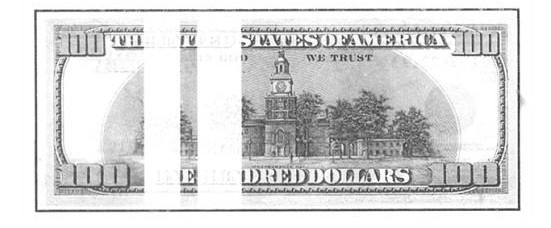
Fig. 2. Infrared image of a 100 USD banknote.

Fig. 3. Infrared image of a 500 EUR banknote.
In addition, IR scanning through transmission allows you to reliably recognize watermarks, security tapes and metallized elements of a banknote. IR scanning allows you to determine the optical density of paper, using it as another testable feature, or simply for rejecting double sheets.
UV tags
As one of the security features, banknotes contain marks applied with phosphors , which glow in the visible spectrum when irradiated with ultraviolet light. There are phosphors in all the colors of the rainbow, so the banknote looks very beautiful under UV.

Rice. 4. Ultraviolet marks of the 100 RUB banknote, modification 2004.
Dollars look much more modest, one narrow stripe glows, the color depends on the denomination.

Rice. 5. Ultraviolet tags of the 50 USD banknote.
But the euro sparkles with all its colors.

Rice. 6. Ultraviolet tags of the 500 EUR banknote.
Security fibers (for RUB and EUR) also have luminescent properties, and different fibers have different glow colors. In woven fibers on rubles, one thread glows and the other does not, causing the fiber to appear dotted. Another security feature is the absence of background luminescence of the paper. Regular writing paper contains optical brighteners, which cause it to glow blue under UV light. Money is printed on unbleached paper, which does not produce a background glow.
To check UV tags, the validator is equipped with an ultraviolet lamp or LEDs (360-380 nm). The glow of the tags is captured by photodetectors of the visible spectrum, which are covered with light filters that cut off primary ultraviolet radiation. The simplest detectors only check the absence of background luminescence of the paper; higher-level devices take a full scan. The glow of protective fibers is practically not checked due to their small size and irregular arrangement.
Magnetic tags
Some areas of the banknote are coated with ink that has magnetic properties. For example, on Russian rubles of modifications up to and including 2004, the banknote number (green) is magnetic. On rubles of the 2010 modification, certain image fragments have magnetic properties.
Rice. 7. Magnetic elements of the 1000 RUB banknote, modification 2010.
US dollars have several magnetic zones of bizarre shape.

Rice. 8. Magnetic elements of the 100 USD banknote.
The euro has a magnetic security thread, a number and a fragment of the image.


Rice. 9. Magnetic elements of the 500 EUR banknote.
Magnetic tags are divided into “hard” and “soft”. The first ones are made using hard magnetic materials and can retain their own magnetization. “Soft” tags are demagnetized immediately when the external field is turned off. To recognize magnetic marks, read heads similar to conventional tape heads are used. Validator heads are usually wide (2-5 cm) to cover a larger area. To read “hard” marks, the banknote is first dragged over a permanent magnet and then over heads that catch residual magnetization.
Special element “I”
Conventional phosphors emit light with a wavelength longer than that of the exciting radiation. For example, when exposed to ultraviolet light, visible light is emitted. There is a class of substances called anti-Stokes phosphors for which this law does not hold. The action of the protective element “I” is based on the properties of anti-Stokes phosphors.When an element is illuminated with intense infrared light (with a wavelength of 940-960 nm), it begins to emit in the green region of the spectrum (~520 nm). On rubles, anti-Stokes marks are located on the front side at the bottom left (gray digits of the denomination) and on the right (gray background of the denomination).

Rice. 10. Anti-Stokes elements of the 5000 RUB banknote, modification 2010.
There are luminescent tags with a more complex testing method, for example, those requiring laser irradiation and glowing in the IR range.
Special element "M"
This protection element is a paint that has different absorption coefficients in different parts of the spectrum in the IR region. If the banknote is illuminated alternately with 940 nm and 850 nm light, the "M" element will appear to blink (when viewed under IR light, again).On modifications of rubles before 2001, such an element was present in the form of a dot, ribbon or image area. There is no reliable data about later modifications.
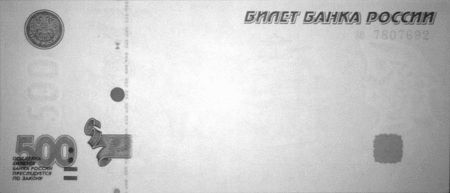
Rice. 11. Special element “M” of the 500 RUB banknote.
On US dollars, the Treasury seal has similar properties.
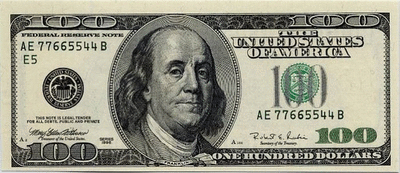
Rice. 12. Special element “M” of the 100 USD banknote.
Secret signs
In order to make the work of counterfeiters more difficult, information is not published about all security features. There are classified security elements that are not known to the general public, and which are verified only by the Central Bank itself. Patents can serve as an indirect source of information about them. A lot of interesting things can be used to protect against counterfeiting .For example, identification by the characteristics of the glow and afterglow of the phosphor. Or the use of electroluminophores. Or the introduction of fibers with magnetic properties into the paper pulp. Or metallized elements that have strictly defined resonances in the microwave range. Or even nanodiamonds (no joke!).
Goznak for car manufacturers sells a special device for checking special characteristics (produced at the LOMO plant in St. Petersburg). It works like a USB device. What’s inside is unknown; for reliability, the entire device is sealed.
Banknote processing devices
Viewing detectors
The viewing detector only visualizes the security features, and the operator decides whether the banknote is genuine or not. On the one hand, the device turns out to be as simple and cheap as possible, but on the other hand, it requires certain operating skills.An ultraviolet detector consists of one or more UV lamps, often with a magnifying glass and a graticule. The luminescence of protective elements is checked by eye.

Rice. 13. Ultraviolet detector CoinMate SLD-16M.
The infrared detector is a little more complicated. It contains IR illumination of the work area, a camera with an appropriate filter, and a display showing the image from the camera. To control the special element “M”, two groups of illumination are used, with different wavelengths, which are turned on alternately. The special element appears to be blinking.

Rice. 14. Infrared detector Grace IRD-800.
There are combined (IR + UV) devices. In addition, viewing detectors can be equipped with remote cameras (for studying suspicious fragments “up close”), magnetic mark detectors and similar accessories.

Rice. 15. Universal detector Dors 1200 with a remote camera and a magnetic mark visualizer.
Automatic detectors
The automatic detector does not require special knowledge from the user
Show animation

Rice. 16. Operating principle of an automatic authenticity detector
The simplest detectors have only a few single photodetectors and thus scan several individual lines of an image, usually in the infrared range. More advanced models read the full image of the banknote using a photo-detecting ruler. Additionally, magnetic sensors and UV illumination may be present.

Rice. 17. DoCash 430 open path detector. Discrete photo sensors and magnetic heads are visible.

Fig. 18. Dors 230 open path detector. The photodetector line is visible.
Counters and sorters
The main disadvantage of automatic detectors is their low operating speed; they accept banknotes one at a time. What if there is a lot of money? For such cases, banknote counters were invented: a bundle is loaded into the machine at once, and it quickly (at a speed of 600-1500 pieces per minute) scans the bills one after another, carefully placing the counted bundle in the output pocket.Show animation
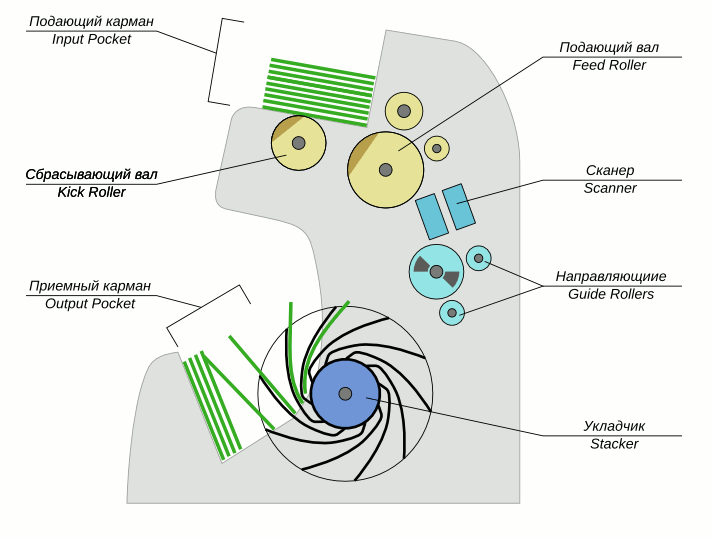
Rice. 19. The principle of operation of the banknote counter
There are two main ways to flip a stack.
- Mechanical. In front of the tract there are rollers made of “sticky” rubber and rollers made of dense rubber. In the simplest case, the pack is located above the rollers that push the bottom bill into the tract, and in order for the bills to enter one at a time, there are rollers above the entrance to the tract that rotate in the opposite direction, which push the extra bills back.
- Vacuum. The pack is pressed against the perforated belt, a reduced pressure is created under it, and the bills stick to the belt, which drags them into the tract.
It is worth saying that not all meters have authentication. The simplest models cannot do anything other than mechanically count and reject sticky banknotes or sheets that differ greatly in size (for example, scraps).
Higher class meters already have UV and magnetic tag sensors. Even more expensive machines perform a full scan of the banknote in the IR range. From this moment on, the counter is already able to determine the currency and denomination of bills passing through it. You can count a stack of money and immediately find out how many banknotes of each denomination are in it, and what the total amount is.
High-end counters scan in the visible, IR, and UV ranges, read magnetic marks, and also measure paper thickness using a mechanical or capacitive method. The latter feature allows you to distinguish new banknotes from worn, torn and glued ones. Thus, the counter can sort by currency, denomination, orientation, authenticity and wear.
Such counters, as a rule, have two receiving pockets: the main one and the reject one, which allows you not to interrupt the counting process when a suspicious banknote is detected.
Show animation
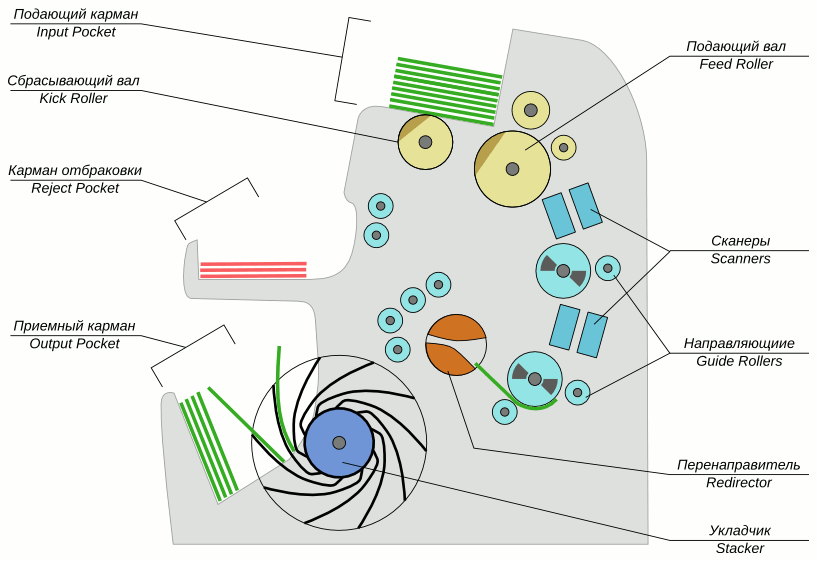
Rice. 20. The operating principle of a two-pocket banknote counter-sorter.
Multi-pocket devices, more often called banknote sorters, trace their origins to the two-pocket counter. The simplest of them look like a regular table counter, slightly “bloated” in height, with several storage pockets.

Rice. 21. Kisan K500 Pro sorter.
And in the highest price segment there are real monsters: machines that take up an entire table (or even several), with a dozen pockets, with the ability to expand, with additional modules for packing money, with validation of everything possible,
Bill acceptors
Bill acceptors are used in vending and gaming machines, payment terminals, ATMs and other self-service systems. They provide cash acceptance, denomination determination, banknote validation and placement into lockable cassettes. The requirements for stand-alone validators are quite high: a double-sided multi-channel optical scanner, UV and magnetic detectors are almost always used. Bill acceptors are equipped with various systems that prevent interference with the mechanism and fraud. For example, a foreign object detector detects the presence of a fishing line or tape that can be used to pull the banknote back. To protect against vandalism, bill acceptors can be equipped with protective curtains ( shutters ).Mechanisms for accepting money are divided into banknotes and bundles. The first ones “eat” one banknote at a time, feeding with the narrow side of the sheet forward. Batch mechanisms accept a stack of banknotes at once, count them, determine denominations and validate them. Such bill acceptors are installed mainly on ATMs, although there are attachments for ordinary bill acceptors that allow you to take a pack of notes (up to 20 banknotes) at once, and then feed it inside one sheet at a time.


Rice. 22. JCM UBA bill acceptor assembled with a cassette and separately.
The deposited banknotes, after passing through the validator, end up in the deposit office (Escrow) . The volume of this compartment may vary: from 1 bill to the entire deposited pack. If the transaction is cancelled, banknotes from escrow will be returned. If the transaction is confirmed, the banknotes are placed in a cassette (Cashbox) - a locked and sealed box. The bill acceptor mechanism can no longer get money out of the cassette. The volume of cassettes can be from several hundred to several thousand banknotes. Sorting by denomination is usually not carried out; all bills in a row are shoved into the cassette.
Separately, it is worth mentioning recyclers - devices that can both accept and issue cash. The recirculator should not be confused with a pair of separate devices: receiver + dispenser. In the latter case, separate cassettes are used for receiving and for issuing, and deposited bills can only be issued through collection.
The recycler accepts money, sorts it by denomination and places it in separate cassettes. From these same cassettes he can issue banknotes or, for example, count out change. Requirements for validators in recycling systems are the most stringent. For example, no more than two dozen models were tested at the Central Bank of the Russian Federation.
Verification algorithms
Before talking about the algorithms used, it is worth noting that the hardware in different classes of devices is very different (Thank you, Captain Obvious!). The simplest detectors operate on 8/16-bit controllers, and it is difficult to implement complex checks or process large amounts of data in them. High-level detectors, bill acceptors and banknote counters are usually controlled by ARM controllers or something similar. To speed up individual operations (image processing, frequency conversions), DSP coprocessors and FPGAs are used. Manufacturers of large bank sorters usually install some kind of industrial computer running Win CE, Linux or QNX inside.To simplify the operation of the software, data from all scanners (visible, UV, IR, magnetic) are combined into one multi-channel file. If necessary, the image is aligned and normalized.
Data processing is carried out in three stages:
- Definition of currency and denomination.
- Authentication.
- If required, determine the wear and tear of the banknote.
Manufacturers of banking equipment carefully protect their algorithms and know-how, so we will have to tell only the most general points. Naturally, a simple pixel-by-pixel comparison of a scan of a banknote with a sample will not give anything good; noise, uneven feeding, different degrees of wear of banknotes, and a bunch of other things contribute.
Most validation algorithms are based on testing individual characteristic features that have good repeatability. For example, several carefully selected areas of the scan are isolated for analysis and the image parameters in these areas are compared with the samples and with each other. The parameters to be checked can be:
- overall brightness and contrast of the area
- image histogram characteristics
- statistical points
- image moments
- correlation functions
- frequency characteristics obtained by Fourier and wavelet transforms
At the first stage, using the simplest and fastest algorithms, the validator determines what kind of banknote is in front of it: what currency and what denomination. That is, in a short time, most of the options that this banknote cannot be are cut off . If, as a result of the selection, there are no applicants left, the bill is rejected as unrecognized.
Once the most likely candidate (or several, depending on the implementation) has been selected, the actual validation begins. The system checks a set of features characteristic of a specific denomination of a specific currency. There are “hard” signs, the first discrepancy of which will reject the banknote, and “soft” ones, which lead to rejection “based on the sum of points”.
Match/fail thresholds are usually adjusted to eliminate Type I errors —the false passing of a counterfeit bill. In this case, the frequency of errors of the second type (false refusal of a valid banknote) ranges from 0.3% (for counters) to 6% (for automatic detectors and bill acceptors).
The description of all checked features is stored in the currency database : a separate entry for each denomination and each modification of the banknote. Money from different years of issue are similar only in appearance, but the arrangement of security features is completely different. There are single-currency and multi-currency executions of validators. In the latter case, the currency can be selected by the user or determined automatically.
Modern validators support database updates via the network, when connected to a computer or from a flash card. By updating, you can add support for other currencies, new modifications of banknotes and improve recognition of old ones. To prevent analysis and reverse engineering of algorithms by unauthorized persons, the databases are transmitted and stored on the device in encrypted form.
Prospects and forecasts
Number tracking
Many bank-grade counting and sorting machines have the function of recognizing banknote numbers. In most cases this feature is not used. At least, there is no unified number tracking system yet. Several years ago, the Central Bank of Russia began an experiment to register the numbers of cash passing through it. On a trial basis, equipment for reading numbers is installed in cash settlement centers.Number tracking has three main purposes:
- fight against counterfeiting
- theft investigation
- assessment of the rate of depreciation of money
There is not yet and there are no plans to compulsorily equip commercial banks with registrars. But when such a system begins to work everywhere, it will actually mean the end of the anonymity of cash. It will be possible to track the movements of each individual banknote, and “black lists” of numbers will appear, for example, of stolen banknotes. Like credit cards, cash can be “blocked” by calling the bank.
RFID tags
The European Central Bank is conducting research into the use of radio frequency tags (RFID). Similar studies are being conducted in Japan. The tags are planned to be introduced into banknotes primarily as a degree of protection against counterfeiting. Indeed, modern cryptographic RFID tags are quite well protected from hacking and copying. The technology is still limited by the relatively high cost of the tags (it is profitable to equip them only with banknotes of large denominations) and their low survivability.Widespread RFIDization of banknotes would, in theory, enable a global cash tracking system similar to number recognition, and even more efficient. However, all sorts of side effects are possible, such as pickpockets who will select victims using portable scanners. The paranoid people have already stocked up on
Non-reproducible tokens and cryptographic money
All modern methods of protection against counterfeiting are based on the secret technology of making the tag. That is, the bank knows how to print a secure bill, but the counterfeiter does not. Such a system, like any other based on Security through obscurity, cannot be considered 100% reliable. Information leaks occur, and attackers find ways to forge increasingly complex tags.
There is a fundamentally different approach based on the use of irreproducible marks. That is, each copy of the tag is unique due to its nature; even the issuer himself cannot make a duplicate. If the mark carries any information, then each banknote can be identified by it. It is enough now to create a database storing the identifiers of all genuine banknotes. Anyone who is not in the database is a fake.
The use of asymmetric cryptography is even more convenient. After the tag is produced, the bank reads it, encrypts it with its private key and prints it on the banknote in the form of any machine-readable message (for example, a bar code or magnetic recording). For validation, it is enough to decrypt the identifier using the public key and compare it with the tag data. A duplicate banknote cannot be made due to the irreproducibility of the mark, and it is impossible to issue another one without knowing the bank’s private key.
The main difficulty of this technology is that the tag must be created based on random processes, but at the same time must be read reliably and repeatably. One possible mechanism is the use of speckle scattering patterns. A suspension of glass beads in epoxy polymer or even just the surface of paper is used as a mark. This technology is currently used to protect art, but can soon be used for banknotes.
Quantum money
A further development of the idea of irreproducible marks is quantum money. The mark is a set of particles in certain quantum states. Cloning the tag will be impossible due to the fundamental laws of quantum mechanics (No-Cloning Theorem).Today, such a defense belongs to the realm of science fiction. So far, no methods have been found for long-term reliable storage of quantum states even in laboratory conditions, not to mention their implementation in banknotes. In addition, recent research in the field of weak measurements calls into question the very impossibility of copying quantum tags.
P.S.:
In the picture to attract attention is Porter Counterfeit Detector, a counterfeit detection device produced in the 1920s-40s in the USA. The banknote being checked was placed under the glass along with a banknote that was known to be genuine, and comparisons were made using rulers and a scale grid.More detailed description and other photographs
The author expresses gratitude to the ice2heart hubbrowser for valuable comments and additions.
List of used literature
- cbr.ru - description of signs of authenticity RUB
- ecb.int - description of EUR authenticity features
- newmoney.gov - description of signs of authenticity of USD
- banknot-spb.ru - special element “M”
- banknot-spb.ru - special element “I”
- cbr.ru — List of software and hardware tools operating in recirculation mode, tested by the Bank of Russia
- kiosks.ru - The Bank of Russia will track the path of each issued banknote
- izvestia.ru - The Central Bank puts banknotes under control
- fleur-de-coin.com — RFID banknotes
- habrahabr.ru — Scientists have built radio chips into paper
- Patent US 7067824 — Method, device and security system, all for authenticating a marking
- Patent RU 2344046 - Method for identifying a valuable product with a luminescent type security element
- Patent RU 2344218 - Method for determining the authenticity of a product protected from counterfeiting, and a device for determining the authenticity of a product protected from counterfeiting
- Patent RU 2276409 - Method of protection against counterfeiting and control of the authenticity of valuable products
- Patent RU 2357866 - Method for protecting documents, securities or products using nanodiamonds with active nv centers
- Panent US 6584214 — Identification and verification using complex, three-dimensional structural features
- Patent RU 2385492 - Methods, products and devices for authentication
